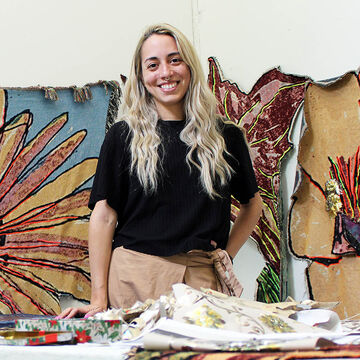| Introduction To Fiber/Material Studies |
Fiber and Material Studies |
2000 (003) |
Spring 2024 |
|
Description
This course introduces students to a diverse range of textile materials, processes, histories, politics, traditions, and cultures of fiber and their relationships to contemporary art practice. Historical and contemporary approaches to process and materials are explored as students are introduced to a variety of fiber techniques in construction and surface application. Taught technique can include printing, tapestry weaving, immersion and resist dyeing, knitting, crochet, felting, coiling, hand embroidery, machine sewing, piecework, and embellishment. Textiles have rich and complex histories in all cultures. Examples from across time and place will be explored and discussed through visual presentations, assigned readings, in-class discussions, visiting artist lectures, and field trips. By the end of this course, students will become familiar with the formal, conceptual, expressive, and political potential of fiber as an expressive medium with limitless possibilities. Course work will vary but typically includes the creation of technical samples, critique projects, and reading responses.
|
Class Number
1204
Credits
3
|
| Introduction To Fiber/Material Studies |
Fiber and Material Studies |
2000 (004) |
Fall 2024 |
|
Description
This course introduces students to a diverse range of textile materials, processes, histories, politics, traditions, and cultures of fiber and their relationships to contemporary art practice. Historical and contemporary approaches to process and materials are explored as students are introduced to a variety of fiber techniques in construction and surface application. Taught technique can include printing, tapestry weaving, immersion and resist dyeing, knitting, crochet, felting, coiling, hand embroidery, machine sewing, piecework, and embellishment. Textiles have rich and complex histories in all cultures. Examples from across time and place will be explored and discussed through visual presentations, assigned readings, in-class discussions, visiting artist lectures, and field trips. By the end of this course, students will become familiar with the formal, conceptual, expressive, and political potential of fiber as an expressive medium with limitless possibilities. Course work will vary but typically includes the creation of technical samples, critique projects, and reading responses.
|
Class Number
1559
Credits
3
|
| Advanced Stitch |
Fiber and Material Studies |
3005 (001) |
Spring 2024 |
|
Description
In Advanced Stitch- Students pursue a strong personal direction while continuing to develop a technical vocabulary and conceptual concerns. Moving across hand stitching and embroidery to using free motion sewing machines, the long arm quilting machines and digital embroidery machines, the class explores themes of gesture, line, speed, slowness, process, and materiality, with an emphasis on surface manipulation and scale. Group critiques encourage individual goals and develop an ongoing dialogue about contemporary issues. Field trips, group discussions, visual presentations, and readings will augment this studio-focused course. Course work will vary but typically includes critique projects, samples, and reading responses.
|
Class Number
1198
Credits
3
|
| Guided Study |
Masters in Fine Arts Low Residency |
6907 (003) |
Spring 2024 |
|
Description
Guided Studies are intensive, self-driven courses of study that have a clear rationale for their configuration and articulate an expressed need in terms of a student's scholarly, material, and theoretical research. As a 3 credit course, a Guided Study constitutes 135 hours of study and production on the part of the student, including four meetings (virtual or otherwise) with a supervising faculty who has expertise in the research areas. On the Guided Study syllabus co-produced by the LRMFA student and supervising faculty, expected research accomplishments must be formulated, alongside a course description, learning objectives, evaluation criteria, a proposed timeline, a communication plan, and a suggested reading list or bibliography. Open to Low Residency MFA students only.
|
Class Number
2512
Credits
3
|

